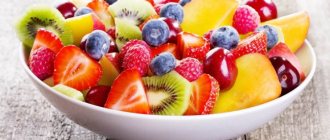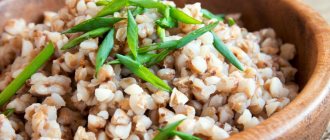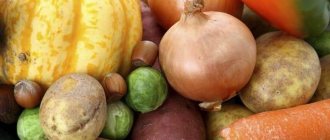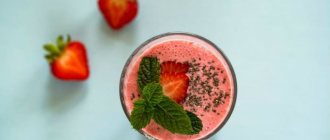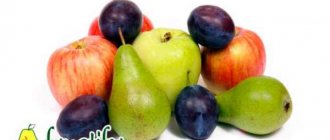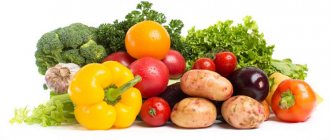It is a common belief that fruits and vegetables are always healthy. In any quantity and in any combination. It would seem that what could be better and healthier than a vegetable or fruit salad. Mix all the fruits that are on hand into one container and enjoy a tasty and, most importantly, healthy dish. But here’s the paradox: salads prepared according to this principle are not always healthy. It turns out that not all fruits and vegetables are “friends” with each other, and the combination of some can even provoke a real storm in the digestive tract.
Rules for combining fruits
Sweet
This group of fruits is represented by bananas, figs, persimmons, dates, sweet grapes and dried fruits. The fruits listed above break down very quickly. As a rule, the stomach takes no more than 15-20 minutes to completely break down the sweet fruit. Due to this feature, it is advisable to eat sweet fruits (as well as juices from them) separately from other types of food.
Content:
- Rules for combining fruits
- Rules for combining vegetables
- Combination of protein foods with fruits and vegetables
- Combining fats with fruits and vegetables
- Combining carbohydrates with fruits and vegetables
- Raw foodists' rules: how to combine fruits and vegetables
- In what order should you eat fruits and vegetables?
- How to combine fruits and vegetables to get maximum benefits
They can be used for snacks between main meals. But you should absolutely not enjoy such fruits immediately after dinner as a dessert, since this will cause fermentation processes in the stomach. Why is this happening? The reason is the heavier food that enters the stomach before the fruit. It usually breaks down within 3 hours. So it turns out: fruits cannot move further through the gastrointestinal tract until the previous food has been broken down. That is, while the stomach is being “cut” with a piece of meat, the remaining fruit begins to ferment. If you eat sweet fruits after a hearty meal, then no earlier than 3-4 hours later.
Fruits of this group are “friends” with sweet and semi-sour fruits. The only exception is bananas, which are best eaten separately from other foods, including plant foods. In addition, sweet fruits can be combined with fermented milk products, cream, sour cream and herbs.
Semi-acid
Apple, pear, plum, grapes (some varieties), peach, apricot, nectarine, raspberry, strawberry, blueberry, blueberry, melon, watermelon. For the most part, these fruits are characterized by good compatibility. They are an excellent “company” for sweet and sour fruits, as well as some protein and fermented milk products. Acceptable combination: semi-acidic fruits and cream, fat-containing foods, greens. It is permissible to prepare dishes from unsweetened fruits, cheeses, nuts, and fatty cottage cheese. At the same time, semi-acidic fruits are not “friendly” with starches, mushrooms, eggs, fish and beans, which require a longer time to break down.
The exceptions to semi-acidic fruits are peaches, blueberries, blueberries, grapes, watermelon and cantaloupe. It is better to eat them separately, since they quickly break down and do not stay in the stomach for a long time.
Sour
The group of sour fruits is represented by lemons, oranges, grapefruits, tangerines, pomegranates, kiwis, gooseberries, cranberries, cherries, some varieties of apples, plums, pears, grapes and apricots. All sour fruits are “friends” with each other, as well as with fermented milk foods (sour cream, cream, cheeses), nuts, and herbs. But you should not simultaneously eat sour fruits and protein foods of animal origin, as well as vegetables and starchy foods.
Compatible and incompatible products
Why do we sometimes get up from the table with a feeling of lightness and a surge of energy, then we fly on wings all day and manage to do a lot of things, and sometimes after lunch we want to lie down and not open our eyes until dinner? Why does one meal give you strength, while another takes it away? It turns out that there are products that are either “friendly” with each other or conflict. Depending on this, the digestion process speeds up or slows down. In the second case, the stomach requires additional energy, so we feel a loss of strength and drowsiness. Some delicacies, such as goose with apples or fish with mashed potatoes, can stay in the stomach for more than 12 hours!
Rules for combining vegetables
The first group of vegetables consists of cucumbers, cabbage, radishes, carrots, turnips, rutabaga, beets, sweet peppers, garlic, onions, lettuce, and early varieties of zucchini. It would seem that what all these fruits have in common. The fact is that from the point of view of digestibility, they have approximately the same characteristics. Vegetables from this group go well together both in salads and in hot dishes. Interestingly, when combined with protein, fatty or starchy foods, these vegetables promote better digestion. For example, carrots go well on the same plate with cottage cheese, cucumbers are a good addition to a piece of meat, and cabbage salads are useful to season with oils. But there are some cautions about eating these vegetables. In particular, they are completely incompatible with milk, and you should not eat the vegetables and fruits mentioned in this section at the same time.
The second vegetable group consists of cauliflower, eggplant, squash, green peas, winter varieties of pumpkin and zucchini. These vegetables can be safely combined with others, including starchy ones, fats, including those of animal origin, and herbs.
The combination of fruits from this group and animal proteins (meat, eggs) is not so favorable for digestion. Well, it is completely incompatible with fruits and milk.
The third group of vegetables are starchy. These are potatoes, corn, edible chestnuts, rice and other grains. Products from this group combine well with other vegetables, herbs and fats. By the way, if you decide to cook starches with butter, be sure to add herbs to them. This combination of foods makes food easier to digest. But combining starches with each other is not the best idea. Especially for overweight people. It is also not recommended to combine starchy vegetables with carbohydrates and/or proteins on a plate.
Dill, parsley, sorrel, spinach, lettuce, cilantro and other greens go perfectly with any product except milk.
And a few more tips on combining vegetables. Almost all of them go well with animal proteins, especially cheese, fish, seafood and eggs. It is useful to add seeds and nuts, including pine and walnuts, to raw vegetable salads. Greens and green vegetables are compatible with absolutely everything, but sour ones, including tomatoes, should not be mixed with carbohydrates. You should not add sugar or sweet fruits to dishes made from starchy vegetables - this causes fermentation in the stomach. In addition, you should not eat cucumbers and tomatoes at the same time. The fact is that cucumbers contain substances that destroy vitamin C in tomatoes. Although if you do not consider tomatoes as the main source of ascorbic acid, then you don’t have to give up a salad of tomatoes and cucumbers.
Sweet fruits
You may be interested in: How to pickle onions for herring. Recipes, methods, tips
When it comes to sweet fruit combinations, bananas, persimmons, figs, melon and papaya immediately come to mind. It is also customary to include various dried fruits in this group: raisins, dried apricots, dates, prunes.
Such fruits are ideally combined with each other, as well as with semi-acidic foods. Most often they are added to various smoothies and salads. It is this excellent combination of fruits and dried fruits that allows you to create store-bought mixes of dried fruits and nuts, which are a great addition to oatmeal or natural yogurt.
Combination of protein foods with fruits and vegetables
Fish, meat, eggs, dairy products, legumes, nuts, seeds, mushrooms, seafood - all these are foods rich in proteins. Protein foods pair well with most vegetables, especially leafy greens, which help break down proteins faster. Bad combination: proteins with starchy vegetables and fruits. The exceptions are cottage cheese, fermented milk products, nuts and seeds, which “get along” well with various fruits.
Semi-sweet (or semi-sour) fruits
Most of the popular fruits in Russia that can be found on the shelves are semi-sweet. These include various varieties of apples, pears, peaches, nectarines, grapes, plums, watermelon, melon and nectarines.
Basically, nutritionists advise combining fruits in this group with each other, since in this case you can create a harmonious version of the dish. However, in some cases such combinations are still strictly prohibited. The bright individuals here are melons and watermelons, which cannot only be combined with each other, but also in general with fruits from other groups. It was found that such schemes only ultimately lead to severe problems in the functioning of the digestive tract. So if you don’t want stomach problems, then it is best to consume watermelons and melons exclusively separately, about an hour after the main meal.
In some cases, it is allowed to combine semi-sour and sweet fruits. Combinations of pears with figs and dates, as well as apples and bananas, will be successful. You can use various combinations in a variety of dishes, with the only exception - they cannot be added to porridges, since they do not combine well with starch.
Combining fats with fruits and vegetables
Fat-containing foods include animal and vegetable oils, sour cream, cream, lard, fatty fish and nuts. The peculiarity of fats is that when they enter the stomach, they slow down the secretion of gastric juice. This property is even more noticeable if you eat something fatty at the very beginning of the meal. As a result, food stagnates in the stomach and the entire digestion process slows down. Hence the heaviness in the stomach, nausea, and unpleasant belching. To prevent this from happening, it is useful to combine fats with herbs and vegetables from the first and second groups. It is also possible to combine fatty foods with starchy vegetables and some fruits. You can combine berries, such as strawberries, with heavy cream on one plate. But in this case, you should not add sugar to the dish.
A little theory
Each type of food for processing requires a certain composition of gastric juice and enzymes, its own special environment. For carbohydrates it should be alkaline, for proteins it should be acidic, etc. There is no need to tell the stomach: it knows everything itself. Now imagine what position the digestive system finds itself in when it is served, for example, a pork chop with mashed potatoes. Alkaline enzymes immediately rush towards the potatoes, which block the digestion of meat. It will begin only after the potatoes are completely “neutralized.” Everything else is no longer reached, and it moves on in a completely undigested form.
This leads to fermentation processes in the intestines, during which intense release of toxins occurs. The liver and pancreas come into the fight against them, and this is a serious burden for them. If this becomes regular, they may fail. In addition, fecal stones are formed from undigested residues, forming entire deposits in the intestines. Hence - constipation, flatulence, general intoxication of the body.
And this is just one example. There is a whole science of how to combine products correctly. But first, it would be nice to at least know what you can’t combine.
Raw foodists' rules: how to combine fruits and vegetables
In recent years, the list of popular diets has been supplemented with another one - based on a raw food diet. Meanwhile, reviews about this power system are mixed.
While they talk about the benefits of this diet for the digestive system, others, on the contrary, complain that after switching to a raw food diet, the functioning of the gastrointestinal tract has only worsened. Why are the reviews so different? The reason may be in the individual characteristics of the body: this system does not have to suit absolutely everyone. But another explanation is also possible: people simply combine different types of vegetables and fruits incorrectly.
Sugar and fat
Nutritionists strongly advise against combining sugars and fats at one meal. And we are not talking about pieces of refined sugar and butter at all. Now we are talking about the nutrients found in plant foods. Sugars are usually found in sweet fruits, in which they are presented in the form of simple carbohydrates - fructose.
Best materials of the month
- Coronaviruses: SARS-CoV-2 (COVID-19)
- Antibiotics for the prevention and treatment of COVID-19: how effective are they?
- The most common "office" diseases
- Does vodka kill coronavirus?
- How to stay alive on our roads?
Fats are mainly concentrated in nuts and seeds, including avocados, coconuts, and olives. If both components are consumed at the same time, this leads to disruption of the digestion process and food, instead of being broken down, stagnates and rots in the stomach. The reason is that when sugar and fats are mixed in the digestive tract, the fermentation process begins. That is, in order to avoid unpleasant sensations after a meal, you should not simultaneously consume sweet fruits, dried fruits, dates with nuts, coconuts or avocados.
Starch and acid
Our digestive system is designed in such a way that it uses different enzymes to digest different types of food. If you consume several types of vegetables and fruits at the same time, this can cause disturbances in the gastrointestinal tract. Most often, unpleasant consequences occur after mixing products containing organic acids and starch. That is, it is not advisable to simultaneously consume sour fruits, such as oranges or lemons, along with bananas, potatoes or bread rich in starches. The fact is that in this case, enzymes are simultaneously produced that neutralize each other’s effects. As a result, it turns out that none of these products are digested, but remain “lumpy” in the stomach, causing discomfort. By the way, even tomatoes contain a large amount of organic acids. So they should also not be consumed together with starchy ones.
Fats and Fats
Also, do not think that all products from the same food group can be combined “with impunity”. For example, it is undesirable to simultaneously consume plant foods rich in fatty acids. For the stomach, such a combination will be too much: it is very difficult to digest so much fat at one time. So, what products are we talking about? First of all, it is not advisable to mix nuts with vegetable oil, coconuts or avocados. Separately, they are all very useful for the body, but together they are too much.
What are the benefits of fruits?
You may be interested in:How to marinate meat in soy sauce: marinade recipes, ingredients and cooking secrets
Doctors definitely recommend including at least 5 servings of a variety of vegetables and fruits in your diet every day. And this is not at all accidental, since these products have a positive effect on the health of the body. Eg:
- The beneficial substances present in bananas, apricots, grapefruits and peaches help strengthen the cardiovascular system.
- For problems with the gastrointestinal tract, doctors recommend eating melons, pears and pineapples.
- All citrus fruits are very useful for strengthening the immune system, so they are especially recommended to be consumed in winter to provide protection against colds.
You may be interested in: How to cook pangasius in the oven: delicious recipes, baking tips
So if a person knows the right combination of fruits, then he can provide himself with a completely healthy snack that will improve the functioning of several internal organs at once.
In what order should you eat fruits and vegetables?
There is a theory that plant foods should be consumed according to the principle from “liquid” to more “solid”. The basis of this teaching is that all food in the stomach should be arranged in “layers”. Moreover, it is very important that these “layers” be in a certain sequence. Proponents of the theory advise first eating juicy, sour fruits, and then sweet ones, and then you can start eating vegetables (also first juicier and then denser ones). And only at the end of the meal you can eat a handful of nuts. This nutritional system may seem strange to some, but the results of various studies confirm its benefits.
We eat fruits separately!
Fruits often act as dessert. They are light and leave a pleasant aftertaste. But hot dishes eaten before fruit take much longer to digest. Therefore, the fruit begins to rot in the stomach. You cannot refuse them. Fruit intake should be postponed to a later date. For example, 40 minutes after eating.
Baking combinations
If you decide to create the ideal combination of berries and fruits in a cake, then attention should be paid to the following variations:
The most ideal combinations
You may be interested in: How to make smoked mackerel at home?
Of course, if you are a fan of experimentation, you can try to create combinations yourself by trial and error. However, some of the most delicious fruit combinations are now known. Here are some of the most popular ones:
Fruit and berry combinations
Berries are an incredibly tasty delicacy that simply amazes with smells and tastes. Therefore, if you create the right combination of fruits and berries, you can get the perfect dessert or cocktail. Now let's talk about the ideal combinations of these two products:
Correct combination of vegetables and fruits
Individually, fruits and vegetables are incredibly beneficial for the body, as they contain huge amounts of essential amino acids, vitamins and minerals for the body. You need to know how to combine them correctly in order to get the greatest benefit:
- to strengthen the immune system, you can combine carrots and apples in a salad;
- to improve the color and texture of the skin, the ideal option would be a combination of tomatoes, apples and carrots;
- It is believed that the simultaneous combination of cucumbers, celery and apples is an excellent preventive measure to prevent the development of cancer, and also helps lower cholesterol;
- apples, pineapples and watermelons in combination help cleanse the body and remove all harmful waste and toxins from it, as well as improve the functioning of the kidneys and liver.
Of course, not all combinations known in cooking are given here. However, if you know the rules that should be followed when combining, then achieving significant results will be very simple. So if you have the rudiments of knowledge, you can start cooking on your own and creating new tastes in food.

